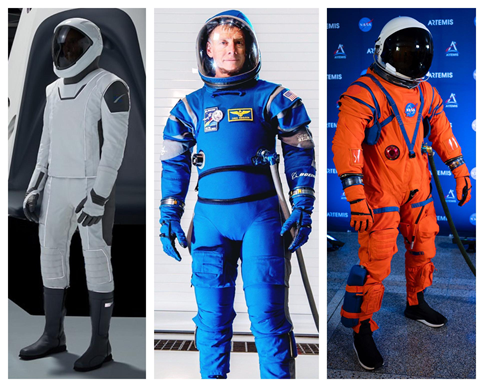Aerospace History: Pressure Suits
This essay was written for Introduction to Aerospace Engineering

From left: SpaceX, Boeing, and NASA IVA suits
Multiple space agencies have allowed astronauts to launch with open pressure suits—the equivalent of driving without a seatbelt—with fatal consequences. Soyuz 11 is the famous example of depressurization: cosmonauts did not wear pressure suits at the time, and the crew was killed by a loss of pressure during reentry [2]. 15 years later, Challenger astronauts launched with unpressurized suits and a 2.5 minute air reserve. Pressurized suits would not have necessarily saved the crew, but there may have been a loss of pressure; three air packs were manually turned on after the breakup [1]. Relying on a spacecraft to remain pressurized is a pointless risk, especially after it caused a tragedy.
I chose the topic of IVA spacesuits because they could be an indicator of overconfidence. Yuri Gagarin wore a pilot’s pressure suit, but Soyuz astronauts didn’t wear IVA suits because the capsule is cramped; the pilot needs a stick to reach some controls. Shuttle astronauts also initially wore pressure suits, until NASA switched to an unpressurized flight suit and helmet. Launching without suits does not necessarily represent overconfidence; commercial airline customers never wear pressure suits inside the pressurized aircraft. Blue Origin plans on launching tourists without helmets or IVA suits, and the only backup is airline-style emergency air [3]. A space agency forgoing suits could indicate overconfidence or an extremely safe design that makes them unnecessary.
Like seatbelts, newer spacesuits are designed to be comfortable, safe, and unrestrictive. Some older suits like the Soyuz’s Sokol are complex to seal: the astronaut needs to manually tie the interior shut after climbing into the suit. In comparison, Boeing and SpaceX’s new suits use airtight zippers to automatically seal the suit as it’s being donned. Both suits also use form-fitting touchscreen gloves to avoid Sokol-esque issues reaching controls [4]. IVA suits are designed to work with their respective spacecraft, and a high-tech refresh is possible with newly-designed spacecraft like the Dragon and Starliner. Some older spacesuits inherit design quirks from the spacecraft, and “New Space” companies are adding modern technology to their fresh designs.
IVA spacesuits are an interesting topic because they’re part of an agency’s mission and imagery. NASA has traditional orange suits, Boeing has blue suits, and SpaceX has a futuristic white suit. EVA suits like NASA’s EMU are common between missions, and not tailored to each astronaut. Commercial space engineers have taken ease of use and fashion into consideration; Boeing’s suit has a soft sweatshirt-style helmet and lightweight boots designed by Rebok. Technological innovations may make an astronaut’s launch and training slightly easier, but better fashion and imagery are also more exciting for the public image of space travel.
[1] P. Recer, “URGENT Challenger Pilot Aware of Disaster, Some Crew Activated Air Packs,” AP NEWS. https://apnews.com/article/8decb522d5d249d6bf75a2981fc0c53a (accessed Nov. 30, 2020).
[2] “The Partnership - ch5-6.” https://www.hq.nasa.gov/office/pao/History/SP-4209/ch5-6.htm (accessed Nov. 30, 2020).
[3] “Here’s what it’ll be like to ride on Jeff Bezos’ suborbital Blue Origin spaceship,” GeekWire, Jan. 28, 2017. https://www.geekwire.com/2017/riding-jeff-bezos-blue-origin-new-shepard/ (accessed Nov. 30, 2020). E. H. 10 June 2020, “New SpaceX spacesuits get five-star rating from NASA astronauts,” Space.com.
[4] https://www.space.com/spacex-spacesuits-five-star-astronaut-review.html (accessed Dec. 01, 2020).
Last modified: 2020-12-01